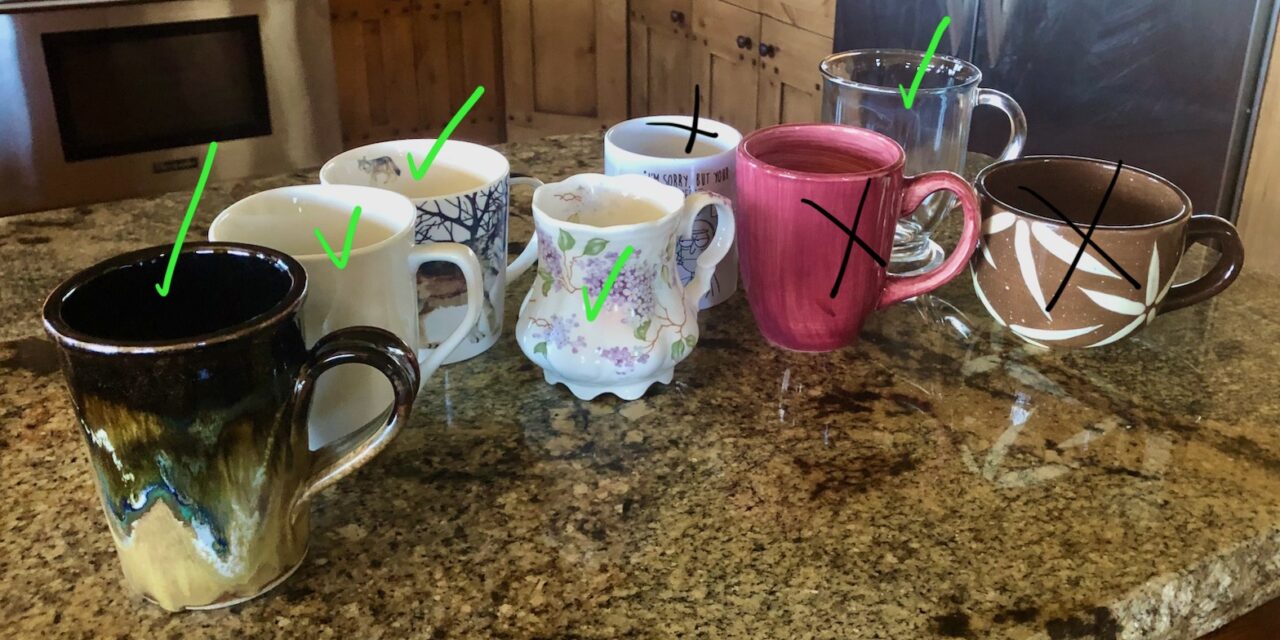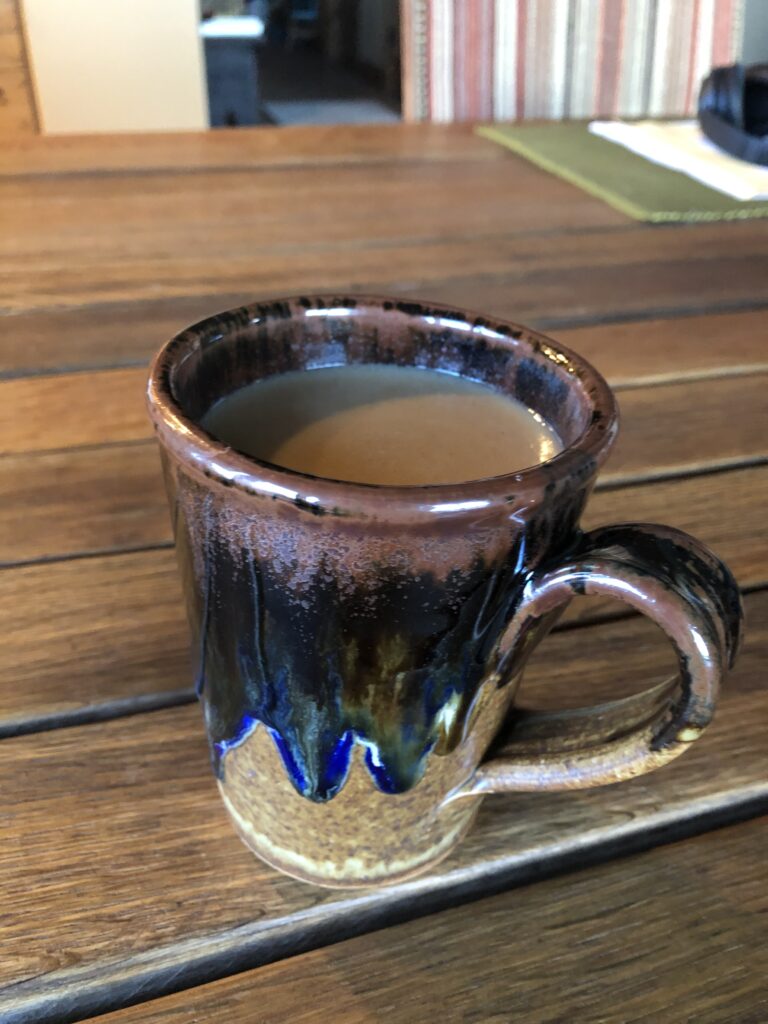I was shopping at Target when I overheard a couple talking about dishes. The man was saying he wanted something that wouldn’t get so hot in the microwave. I understand. I hate those cups that get so hot you can’t pick them up–even the handle is too hot.
I noticed that not all handles get hot in a microwave oven. Some stay cool and you can reach in and take out your hot beverage with calm. So, I began to notice which cups got too hot and which ones stay cool. You can look at the bottom of a cup or mug to determine its material. (Usually)
There are three main types of ceramic/pottery — earthenware, stoneware, and porcelain. There is also bone china which is probably the same as porcelain. Then there are glass mugs, and plastic insulated cups.
Types of Ceramic
Earthenware
Earthenware is a clay that has been fired at 1,000 to 1,150 degrees C — thus it is nonvitreous (not fired to a glass-like state) — It can be brittle and porous. Some are glazed to make them waterproof, otherwise, the porous nature makes them unable to hold liquid (think terra cotta pot.) So you may run into a glazed earthenware cup, but I have yet to see a cup stamped on the bottom as earthenware.
Stoneware
Stoneware is a clay that has been fired at a temperature higher than 1,200 degrees C. It is vitreous or somewhat vitreous and thus becomes hardened and denser and can hold liquids without a glaze. However, cups and mugs made from stoneware can be either glazed or unglazed. And they can get either too hot or not. So I just stay away from the manufactured ones (especially those made in China)
Most Stoneware cups get hot in the microwave oven.
I’ve found that most stoneware mugs get too hot in a microwave, like this pink cup. It says microwave and oven-safe. But most of them get too hot in the microwave:
Porcelain is a refined clay that is fired to a temperature between 1,200 and 1,400 degrees C.
I noticed that the cups made from porcelain or bone china–stayed cool. Heat your hot water or milk for a few minutes, open the microwave door, reach in, and pick up the cup by the handle. It is not hot–only your beverage. The same goes for the plates or bowls made of porcelain and bone china.
Even though stoneware says microwave safe, that does not mean it stays cool. It just means it won’t break in there. I want a cup or mug handle that stays cool in the microwave so I can pick it up after I have heated the contents of that cup.
I went over to the next aisle and shared my in-home kitchen research.
“Look for something made from porcelain or china.”
They showed me the set of dishes they had in their cart and asked–“Is this the kind–it’s stoneware?”
“No, that’s the one that gets too hot.” I looked over the available dishes at Target and found the ones I had most recently purchased–looking at the box it read, “porcelain.”
Most Stoneware, though safe for microwaves, is made of clay, which contains water molecules that get HOT, Just like the water in the cup.
Cups and mugs made out of a material with a higher water content will get hot.
Porcelain or Bone China Cups do not get hot in microwaves.
Porcelain is made from high-quality clay that is vitrified, is non-porous, and usually translucent. The term “China” developed because that’s where these dishes originated in the 9th century. In the 1700’s it made its way to England. This was when bone china came into use — about the mid 18th century in England, and they were trying to vitrify at lower temperatures. They couldn’t get their kilns hot enough to vitrify, so they added animal bone ash to produce china at a lower temperature. With this method they produced china that was lighter, whiter and stronger, and hence the name–Bone China:
I found this great mug in Park City, Utah. The handle stays cool in the microwave oven. The artist, Larabee, who makes these mugs explained to me that the porcelain and stoneware creations are fired in a gas kiln to 1,315.5 degrees C. Larabee uses a clay body that is a white stoneware and porcelain hybrid. With no iron ore Brown materials in the clay it does not conduct heat from the microwave. Most earthenware and Brown stoneware have a lot of iron oxide in it which causes the handles to heat up in the microwave. All of his work is high fire cone11 porcelaneous clay body and it is food safe, dishwasher and microwave safe. Larabee Ceramics
As a rough guide, the kiln temperatures for the three types of ceramics are as follows:
- earthenwares at between about 1,000°C (1,830 °F) to 1,200 °C (2,190 °F)
- stonewares at between about 1,100 °C (2,010 °F) to 1,300 °C (2,370 °F)
- porcelains at between about 1,200 °C (2,190 °F) to 1,400 °C (2,550 °F)
How does a microwave oven work?
“A microwave oven passes microwave radiation at a frequency near 2.45 GHz (12 cm) through food, causing dielectric heating primarily by absorption of the energy in water. “ The water molecule has a positive and negative charge (a polar molecule) which reacts to the microwave radiation by rotating.
Food Safety Management
R. Mitchell, in Encyclopedia of Food Safety, 2014
Microwave Reheating
Microwave ovens reheat foods by dielectric heating: electromagnetic radiation vibrates water molecules in the food to the extent that they generate heat, thereby cooking or reheating the food. It is well recognized that microwave equipment can suffer from uneven reheating, resulting in cold and hot spots. For this reason, the general advice is to use microwaves to reheat foods not cook them and ensure that the food reaches 70 °C for 2 min or equivalent or is ‘piping hot throughout’. Domestic scale microwave ovens are not suitable for mass catering. Industrial scale microwave ovens should have fewer problems with uneven heating and use thermocouples to ensure that the target time/temperature is met.





